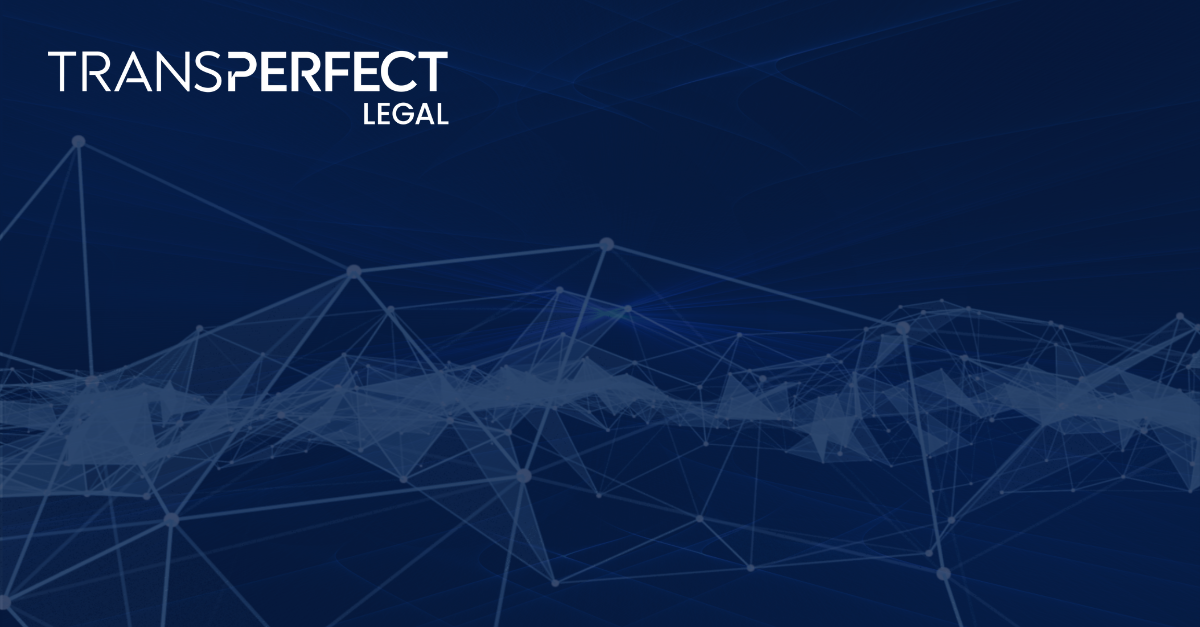eDiscovery Trends for 2025: Navigating Innovation and Challenges
eDiscovery Trends for 2025: Navigating Innovation and Challenges


January may already be in the rear-view mirror, but it’s never too late to get ahead of the eDiscovery curve as we accelerate into 2025. Driven by technological advancements and shifting client expectations, legal professionals must navigate a dynamic environment that demands adaptability and innovation.
This article highlights six key trends set to shape eDiscovery practices in the coming year, offering insights into the latest tools and challenges that legal teams need to be aware of to mitigate greater risk and unlock further efficiency.
1. Generative AI in eDiscovery: From Adoption to Application
Last year, we predicted that 2024 would see legal generative AI (GenAI) tools evolve from mere hype to real implementation. This transformation has certainly begun, though it’s still early days. Practical applications are taking shape, with the official release of tools and workflows for responsiveness review by Relativity aiR, eDiscovery AI, and others. Meanwhile, developers are releasing Retrieval-Augmented Generation (RAG) tools, which promise the ability to interact with vast data universes through the simplicity of a chat-like, Q&A interface.
"With AI-generated content only adding to the exponential growth of data volumes,
leveraging AI for document review to ‘fight fire with fire’ will soon no longer be optional—it’s
the only viable way to keep pace with the rising costs and complexity of document review."
Alys Sciannaca, Senior Director, London
However, GenAI legal tools are still a ways off from widespread adoption in everyday eDiscovery processes. The key challenge for both lawyers and technologists is determining where GenAI-enabled review can deliver the most value with the appropriate risk level at an acceptable price point.
Hybrid approaches that combine generative AI with established Technology-Assisted Review (TAR) workflows are gaining traction, offering a balanced path for firms seeking to reduce costs and improve efficiency while managing risk. RAG models enabling document analysis, chronology preparation, and deeper post-review insights into relevant documents are emerging as the most promising areas for maximizing efficiency gains.
"RAG models will have a stronger foundational impact by becoming essential tools for
compliance, defensibility, and large-scale data management. They address the industry's
most pressing pain points and align well with legal standards."
Junaid Khan, Director, Consulting, London
It’s an exciting time for GenAI and the legal industry. The strong market reaction to DeepSeek’s recent launch underscores the accelerating trajectory of LLMs, demonstrating that high-performance AI can be developed, trained, and deployed cost-efficiently with reduced hardware requirements. Lowering the barrier to entry opens new possibilities for custom AI engines, making advanced legal AI solutions more accessible than ever.
However, the intense focus on AI highlights the critical importance of data as an asset. In a world where data underpins the efficacy, reliability, and intelligence of legal technology solutions, so too does the responsibility to scrutinize it. Lawyers across disciplines seeking to leverage technology must confront key questions about the unintended use of data in training proprietary algorithms and the need for strong data governance—especially amid growing regulatory scrutiny of AI, with the EU AI Act serving as a precursor to broader oversight. A foundational understanding of data is now as unavoidable for the legal profession as the proliferation of AI itself.
2. Scoping and Preparing for Hyperlinked Documents
Hyperlinked documents (often referred to as modern attachments), such as linked or cloud-hosted files, are a ubiquitous challenge in eDiscovery. For example, in Microsoft 365, a user might attach a file stored in SharePoint or OneDrive rather than embedding it directly into an email. While this creates efficiencies for collaboration, it poses significant challenges for eDiscovery. The attached file resides in a separate repository and will likely be missed using traditional forensic collection methods. This requires additional workflows to identify, collect, and process the linked file alongside the email. Platforms like Google Workspace introduce similar complexities with their own linked attachment technology.
These challenges often result in increased costs of recollection as well as adverse inferences being drawn. Handling these attachments effectively requires careful planning and advanced tools that can link, process, and review them together. Early identification and robust workflows can avoid significant problems downstream.
"Client awareness of the challenges and costs associated with modern attachments is
essential to avoid missing documents in review, particularly as their use becomes more
common in M365 and Google environments. Without proper scoping, the risk of project delays and recollections increases."
Harvey Khan, Director, Project Management, Middle East
3. Leveraging the Latest Tools for Strategic Multilingual Review
Multilingual datasets remain a key challenge in cross-border disputes and investigations. Despite the year-over-year increase in non-English data across contentious work—and what appears to be a correlating growth in tools to assist—multilingual data sets continue to cause confusion, increase costs, and lead to misinterpretation of key threads of syntactic investigation. Selecting the right strategy for multilingual data is critical. Concerningly, more lawyers than ever still rely on basic, freely available, unsecured machine translation (MT) tools without proper consideration of language strategy for their case, or broader data privacy concerns.
MT undoubtedly plays a pivotal role in effectively identifying and reviewing non-English data. However, to take one limitation, traditional MT engines have struggled with unstructured content like chat data from WhatsApp or Teams, where abbreviations, typos, and informal language prevented MT from understanding important contextual nuances in the source messages.
For MT to be leveraged effectively, lawyers need to consider the best engines for the relevant datatype. Emerging chat-specific MT engines offer a significant improvement in addressing the linguistic subtleties of chat data—yet human review oversight remains indispensable for ensuring accuracy and preserving detail in review. In the same vein, LLM-driven MT solutions can offer quick insights at a reasonable cost—but they can also be wildly off-kilter for certain language pairs and content, highlighting the importance of carefully selecting the best tool for the job.
"The new type of AI engines underpinning machine translation today are an order of
magnitude better at working through all the linguistic shortcuts, abbreviations, and typos
commonly seen in chat data. However, these solutions should still be considered a halfway house."
Robert Wagner, Global Director of Multilingual eDiscovery, London
4. Anticipating Challenges in Structured Data and Bespoke Platforms
The proliferation of bespoke platforms and structured data sources is another trend continuing to shape the eDiscovery landscape. While this is not the first time we’ve highlighted this challenge, it remains at the forefront of our forensic collections as the number of bespoke platforms increases year-over-year. From construction management tools (e.g., Aconex and ThinkProject) to HR (Workday) and project management systems (monday.com and Slack), these platforms present unique challenges for collection, processing, and review. While these data sources may not always resemble the vast email and document repositories lawyers are used to reviewing for relevance, they often contain the critical conversations and evidence that make or break a case.
"As Chinese corporations expand globally, collections are particularly at risk due to atypical data sources. For example, one client is working on a $200M construction project that was handled entirely on WeCom (server solution from Tencent) at the insistence of a Chinese contractor; which differ vastly from incumbent platforms like Aconex."
Adrian Lee, Director, Hong Kong
In many cases, proprietary tools or APIs are required to extract data while preserving its integrity and associated metadata. At the same time, specialized processing solutions play a critical role in converting this data into reviewable file formats.
Volume-based pricing models for exporting data from these platforms can add complexity to project budgets, underscoring the need for early scoping and collaboration between lawyers, client platform administrators, and eDiscovery consultants. As these data sources become more prevalent, investing in specialized workflows and tools will be essential to manage them effectively.
"Our bespoke workflows enable us to tackle challenging data sources like Aconex, Xero, and other custom repositories. It is critical that we work closely with client environment administrators to ensure efficient, tailored collections are carried out in a suitably defensible manner."
Alex Seigle-Morris, VP, Forensics Technology and Consulting, EMEA and APAC
5. The Increasing Adoption of Early Case Assessment (Finally!)
Early Case Assessment (ECA) is gaining momentum as a critical workflow for managing ever-rising data volumes and controlling costs. Strategically spending time in ECA at the outset of a matter will enable legal teams to identify relevant data and cull unnecessary information before large-scale review, helping to reduce processing expenses and accelerate timelines in the long run.
"We still see many lawyers fall into the trap of rushing into long, linear reviews, driven by a
false sense of urgency caused by ever rising data volumes. Litigators should all know how
ECA works, the options available, and the insights they can gain before large scale review
begins—the tech won’t do it for them."
Tom Balmer, APAC Director, Sydney
With more clients embracing ECA workflows, legal teams must educate themselves on the available technologies and strategies to maximize its value. Combining ECA with AI-driven analytics offers deeper insights into data, enhancing both the efficiency and accuracy of case preparation.
"In the Middle East, many of our clients are now seeing the potential of ECA to properly investigate their own data systems to effectively make sense of their vast data management repositories and identify key evidence to support potential claims."
Mike Deeker, Middle East Director, Dubai
6. A Unique Opportunity to Upskill
Trends around technology often focus on the delayed reaction of an industry steered by Luddites. If we take composite parts of the law firm business model, there are abundant examples. Partners have shifted case law research to trainees and delegated written correspondence to associates, while focusing instead on the strategic direction of a matter. Millennials often get a bad rap, but in reality, they make up 35% of the workforce and boast its most malleable shared brainpower. Rather than viewing technology as a threat to billable hours, law firms should recognize the opportunity it presents to maximize resources. Tech-savvy lawyers can complete tasks like research and drafting in a fraction of the time—with strong technology skills, and most importantly, the ability to critically check AI-generated output. Law firms are better placed than many businesses to achieve the age-old dream of “doing more with less” by investing in upskilling their junior lawyers.
Law schools and professional development programs must adapt to this shift by integrating legal technology modules into their curricula. Firms should seek out opportunities to run parallel tech-enabled workflows and monitor results in real time. The relative costs are small, but the insights gained can be seismic for future business modelling. Rather than relying on lawyers who happen to have an interest in technology, senior partners should empower their juniors to lay the foundation for future-proofing their practices.
"As law firms integrate AI, junior lawyers will play a pivotal role in adopting and refining these tools. Firms should invest. Where budgets constrain investment at the level requisite to manifest real change, they should forge partnerships with academic institutions and technologists to quickly upskill their teams. This will ensure junior lawyers shape the future of legal work and add strategic value to the firm."
Al-Karim Makhani, VP, EMEA and APAC, London